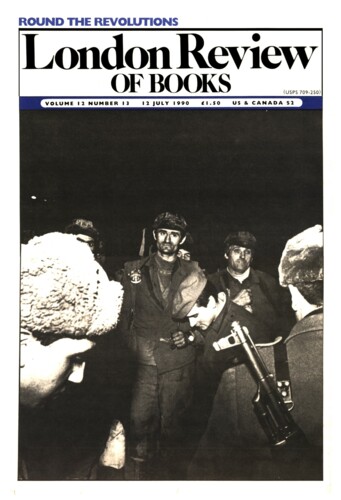From David Hockney’s Lord of Misrule to its repetition on the back of the jacket, this book is a bull shot, like the cocktail at the bar in Langan’s Brasserie. It consists of Langan’s self-portrait, written in the sleepless marches, to which the art critic Brian Sewell has contributed a memoir of friendship which will come as a pleasant surprise to readers more accustomed to his inspired Sowerberry in the columns of the Evening Standard. Last month on his birthday Peter’s wake was celebrated by hundreds in what is still the most successful London restaurant of our times.
In the Sixties, before the age of artolatry and when gala programmes were few, I had never met until Peter a man for whom painting and drawing never lost their magic. Although he did not draw, images had a force for him. He can be said to upset David Sylvester’s definition of the man who draws as the only man who sees. Hence his apparent meekness towards the artist, the hungry artist, we may add, which was noted by Brian Sewell when he and Peter went to David Hockney’s studio. His behaviour and utterance were always colourful, and artists warmed to him, as did taxi-drivers, policemen and women. He once said to me: ‘Patrick, you’ve got a high gloss.’ I was flattered, like some polished banister.
His own story begins with particularly vivid descriptions of boyhood in Clarecastle. The sex is hilarious and the recipes are inspiring and clear. On preparing mussels: ‘If they are open and won’t stay shut when tapped discard them. The buggers are dead.’ Buggery figures in Brian Sewell’s description of Peter’s treatment of my Venice, the paintings he commissioned for the upper room of Langan’s Brasserie. But he is wrong to say they were painted direct onto the plaster. They are not. I had constructed detachable panels to the measurements all round the room: detachable but designed to last, like Oliver Messel’s Venice, which adorned the same room in the Thirties, all striped poles and cotton-wool pigeons, and which remained until the Coq d’Or. Peter was considerate enough when obliterating what he referred to as the ‘Ghost-Ship’ on the end wall to use a distemper which may be removed with water, as he afterwards confessed in the Times. The anchored white liner counted for more in his eyes than did the cycloramic unity of the series, which the unmasking of the ‘Riva degli Schiavoni’ would restore. I cannot help liking better than buggery the ‘Switch-Hitter’ which Peter gave to the English language (no remote controls in Castleknock in his day).
Peter’s vanity was consistent with his more golden qualities. Brian Sewell’s suggestion that Kirsten should have minded about his marriage with Susan is entirely disproved by the reality of their, Kirsten’s and Susan’s, lifelong friendship, let alone his friendship with myself. Kirsten gave him Odin’s to run, his first restaurant, and married me. He threw our wedding party with hot oysters.
One canine cavil to Sewell for omitting Peter’s entertainment of Spade, our blue-black Welsh water-spaniel, who had his photograph in the Observer’s Pendennis column seated at a table dressed in a double damask napkin. On the other hand, while all the artists worshipped the success of Francis Bacon, it mattered not at all that he did not frequent Odin’s. He preferred Muriel’s and could keep it, though Peter was presented with a serigraph from Richard Hamilton which is a Bacon copy.
In other respects Sewell’s account is remarkably fair, and, like Keith Vaughan’s journal, painfully honest, and endearingly so, about his own highs and lows with Peter. The hero of course is best expressed in his own words. Once the Brasserie was established, Peter conceived the idea of opening in Los Angeles. What convinced him that California would take to tripe and onions we can only surmise. Perhaps its North of England ancestry? Certainly David Hockney and I craved un-American food when we were together there in 1965 (and bought delicious Scottish kippers at downtown Santa Monica’s Farmer’s Market). But not only Californians have failed on tripe. When Peter visited my studio in London for the last time, on his return from California, Susan was with him and he turned to her and asked: ‘Do I own this restaurant?’ Even when tired, he had large pink ears of childlike softness and pearl.
We his memoirist and portraitist are like the monks in his boyhood abbey, like crows mourning the fox – an Sionnac Glic – which Peter fancied himself to be. But he had no guile. The joyous story of his escape from there to a woman in Sunderland has a Boswellian intensity. She is like Hogarth’s Shrimp Girl.
It would be invidious to object to Brian Sewell’s comparison of my watercolour of Peter to a ‘drowned mullet’ – perhaps such fish exist in Ireland? – since it is surrounded in the illustration with a Murillesque galaxy of brilliant pen-and-crayon putti by David, among his finest likenesses. My poor mullet is later described as ‘fine and strong’.
Reviewing his own life, Peter writes: ‘Special days are also sad ones when someone you have loved is dead.’ We must learn what he discovered, the vital power of grief. The postman this morning rang my bell for a recorded delivery: ‘Sign here. Are you the man who painted Peter Langan?’ His fame is secure.
Send Letters To:
The Editor
London Review of Books,
28 Little Russell Street
London, WC1A 2HN
letters@lrb.co.uk
Please include name, address, and a telephone number.

